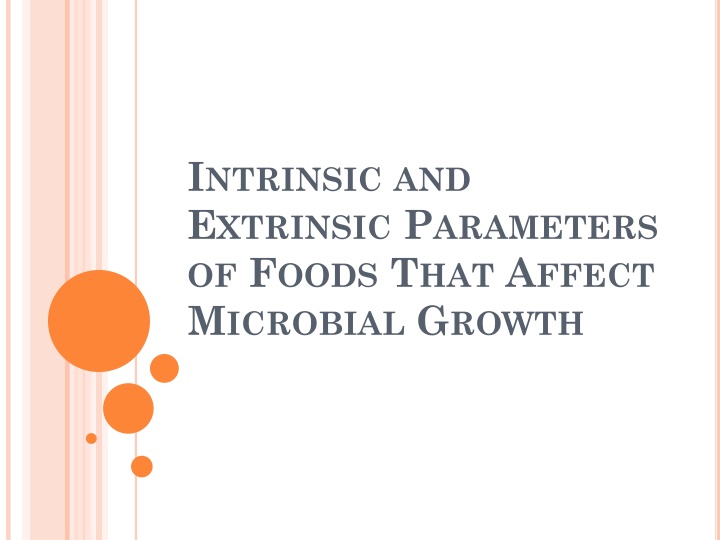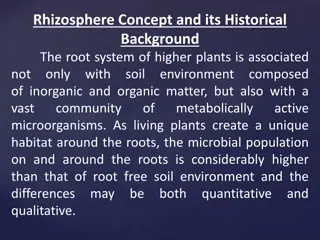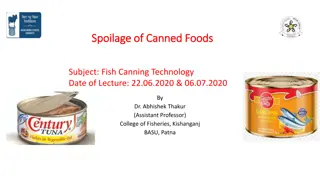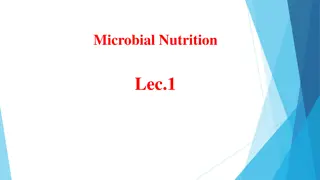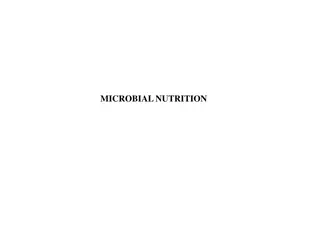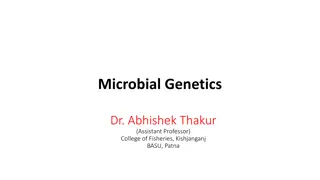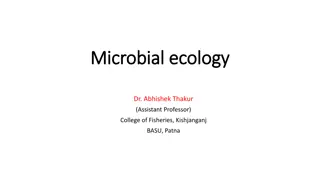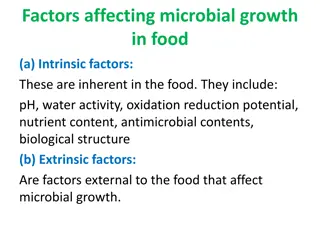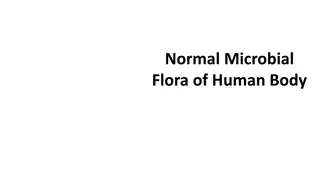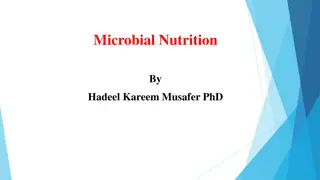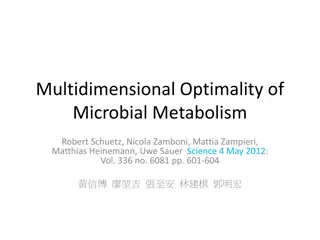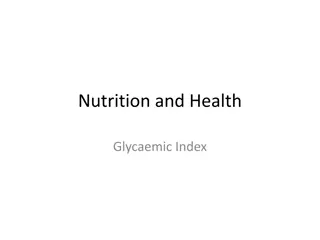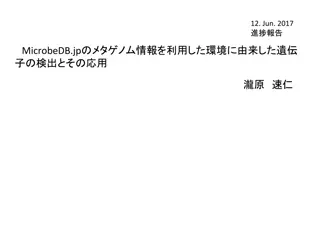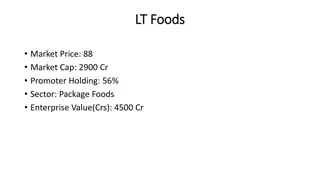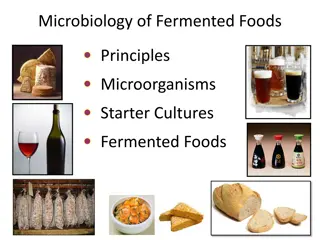Factors Influencing Microbial Growth in Foods
Intrinsic and extrinsic parameters play a crucial role in determining microbial growth in foods. Factors such as pH levels, water activity, and the type of food environment greatly influence the proliferation of microorganisms. Understanding these parameters is essential for food safety and preservation.
Download Presentation

Please find below an Image/Link to download the presentation.
The content on the website is provided AS IS for your information and personal use only. It may not be sold, licensed, or shared on other websites without obtaining consent from the author.If you encounter any issues during the download, it is possible that the publisher has removed the file from their server.
You are allowed to download the files provided on this website for personal or commercial use, subject to the condition that they are used lawfully. All files are the property of their respective owners.
The content on the website is provided AS IS for your information and personal use only. It may not be sold, licensed, or shared on other websites without obtaining consent from the author.
E N D
Presentation Transcript
INTRINSIC AND EXTRINSIC PARAMETERS OF FOODS THAT AFFECT MICROBIAL GROWTH
The ability of microorganisms to grow or multiply in a food is determined by the food environment ( intrinsic environment of food) as well as the environment in which the food is stored (extrinsic environment ).
INTRINSIC PARAMETERS pH Most microorganisms grow best at pH values around 7.0 (6.6-7.5). In general, molds and yeasts are able to grow at lower pH than to bacteria, and Gram-negative bacteria are more sensitive to low pH than are Gram-positive bacteria and pathogenic bacteria being the most fastidious. On the basis of pH, foods can be grouped as high- acid foods (pH below 4.6) and low-acid foods (pH 4.6 and above).Fruits, soft drinks and vinegar all fall below the point at which bacteria normally grow.
Fruits generally undergo mold and yeast spoilage, and this is due to the capacity of these organisms to grow at pH values <3.5, which is below the minima for most food spoilage and all food poisoning bacteria , most of the meats and seafoods have a pH of about 5.6 and above. This makes these products susceptible to bacteria as well as to mold and yeast spoilage. Most vegetables have higher pH values than fruits and vegetables should be subject more to bacterial than fungal spoilage.
Water activity Water activity(aw) is a measure of the availability of water for biological functions and relates to water present in a food in free form. The free water in a food is necessary for microbial growth. It is necessary to transport nutrients and remove waste materials, carry out enzymatic reactions, synthesize cellular materials, and take part in other biochemical reactions, such as hydrolysis of a proteins to amino acids. The water requirements of microorganisms should be described in terms of the water activity (aw) in the environment. This parameter is defined by the ratio of the water vapor pressure of food substrate(P, which is <1) to the vapor pressure of pure water (Po, which is 1), at the same temperature.
aw = p/po, where p is the vapor pressure of the solution and po is the vapor pressure of the solvent (usually water). This concept is related to relative humidity (RH) in the following way: RH = 100 x aw.
In general, bacteria require higher values of aw for growth than fungi, with gram-negative bacteria having higher requirements than gram positives. Each microbial species (or group) has an optimum, maximum, and minimum aw level for growth In general,the minimum aw values for growth of microbial groups are as follows: Most Gram-positive bacteria, 0.90; and Gram-negative bacteria, 0.93. , whereas most molds, 0.80 and most yeasts ,0.88.
Nutrient Content The microorganisms of importance in foods require : water source of energy source of nitrogen vitamins and related growth factors minerals
The importance of water to the growth of microorganisms was presented above. To the other four groups of substances, molds have the lowest requirement, followed by yeasts, gram-negative bacteria, and gram positive bacteria. As sources of energy, foodborne microorganisms may utilize sugars, alcohols, and amino acids. Some few microorganisms are able to utilize complex carbohydrates such as starches and cellulose as sources of energy by first degrading these compounds to simple sugars. Fats are used also by microorganisms as sources of energy, but these compounds are attacked by small number of microbes in foods.
Microorganisms may require B vitamins in low quantities, and almost all natural foods have a large quantity for those organisms that are unable to synthesize their essential requirements. In general, gram-positive bacteria are the least synthetic and must therefore be supplied with one or more of these compounds before they will grow. The gram-negative bacteria and molds are able to synthesize most or all of their requirements. Consequently, these two groups of organisms may be found growing on foods low in B vitamins.
Oxidation-Reduction Potential The O/R potential of a substrate may be defined generally as the ease with which the substrate loses or gains electrons. When an element or compound loses electrons, the substrate is said to be oxidized, whereas a substrate that gains electrons becomes reduced. Therefore, a substance that readily gives up electrons is a good reducing agent, and one that readily takes up electrons is a good oxidizing agent.The O/R potential of a system is expressed by the symbol Eh. Aerobic microorganisms require positive Eh values (oxidized) for growth such as somemembers of the genus Bacillus., whereas anaerobes require negative Eh values (reduced) such as the genus Clostridium.
Some bacteria actually grow better under slightly reducedconditions, and these organisms are oftenreferred to as microaerophiles. Examples ofmicroaerophilic bacteria are Lactobacilli andCampylobacters. Some bacteria have the capacity to grow under either aerobic or anaerobic conditions. Such types are referred to as facultative anaerobes. Most molds and yeasts encountered in and on foods are aerobic, although a few tend to be facultative anaerobes. Plant foods, especially plant juices, tend to have positive Eh values, aerobic bacteria and molds are the common cause of spoilage of products of this type. Solid meats have negative Eh values ,an aerobic bacteria are the common cause of spoilage of products of this type.
Antimicrobial substances The stability of some foods against attack by microorganisms is due to the presence of certain naturally substances that have been shown to have antimicrobial activity. Some species are known to contain essential oils that possess antimicrobial activity. Among these are eugenol in cloves, allicin in garlic, cinnamic aldehyde and eugenol in cinnamon, cow's milk contains several antimicrobial substances, including lactoferrin, lysozyme and the lactoperoxidase system. Eggs contain lysozyme, Ovotransferrin and conalbumin, provides fresh eggs with antimicrobial system. The organic acids found in fruits, vegetables show antibacterial and some antifungal activity.
Biological structures Inner parts of healthy tissues of living plants and animals are sterile or low in microbial content. The natural covering of some foods provides excellent protection against the entry and damage by spoilage organisms. Ex: The outer covering of fruits, the shell of nuts, the hide of animals, and the shells of eggs.
EXTRINSIC PARAMETERS The extrinsic parameters of foods are those properties of the storage environment that affect both the foods and their microorganisms. Those of greatest importance to the welfare of foodborne organisms are as follows:
Temperature of Storage Microorganisms important in foods are divided into three groups on the basis of their temperature of growth : (1) thermophiles (grow at relatively high temperature), (2) mesophiles (grow at ambient temperature), (3) psychrophiles (grow at cold temperature). Therefore, it would be well to consider at this point the temperature growth ranges for organisms of importance in foods as an aid in selecting the suitable temperature for the storage of different types of foods .
Temperature of storage is the most important parameter that affects the spoilage of highly perishable foods. Ex:The psychrotrophs found most commonly on foods are those that belong to the genera Pseudomonas and Enterococcus . These organisms grow well at refrigerator temperatures and cause spoilage of meats, fish, poultry, eggs, and other foods normally held at this temperature.
Relative Humidity of Environment (RH): The relative humidity of the storage environment is important extrinsic parameter both from the standpoint of awwithin foods and the growth of microorganisms at the surfaces. When foods with low awcontents are placed in high RH environments, the foods takes up more moisture until equilibrium has been established. Similarly foods with a high awlose moisture when placed in an environment of low RH. There is a relationship between RH and temperature that should be borne in mind in selecting proper storage environments for foods. Generally, if the temperature high then the RH low and vice versa.
Foods that undergo surface spoilage from molds, yeasts, and certain bacteria should be stored under conditions of low RH. Wrapped meats such as whole chickens and beef cuts tend to suffer much surface spoilage in the refrigerator before deep spoilage occurs, due to the generally high RH of the refrigerator.
Presence and Concentration of Gases in the Environment Carbon dioxide (CO2) is the single most important atmospheric gas that is used to control microorganisms . Ozone (O3) is the other atmospheric gas that has antimicrobial properties. It has been shown to be effective against a variety of microorganisms, but because it is a strong oxidizing agent, it should not be used on high-lipid-content foods since it would cause an increase in rancidity.
Microbial Interference Microbial interference refers to the general nonspecific inhibition or destruction of one microorganism by other members of the same environment. Whereas lactic antagonism is a specific example of microbial interference.The lactic antagonism include bacteriocins, pH depression, organic acids, H2O2, diacetyl, and other products have ability to inhibit pathogens and food-spoilage organisms.
The explanations for interference are (1) competition for nutrients, (2) competition for attachment/adhesion sites, (3) unfavorable alteration of the environment, and (4) combinations of these.
